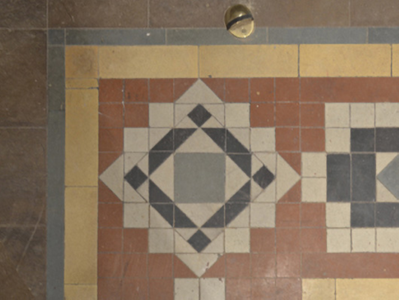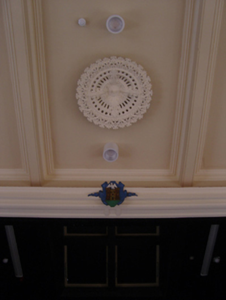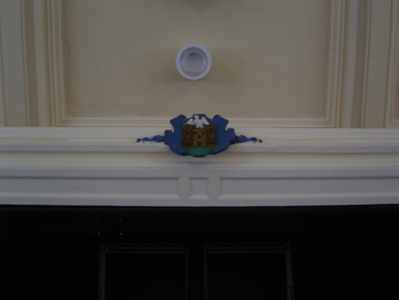Survey Data
Reg No
15603117
Rating
Regional
Categories of Special Interest
Architectural, Artistic, Cultural, Historical, Social, Technical
Original Use
Town/county hall
Date
1890 - 1895
Coordinates
297316, 139825
Date Recorded
13/06/2005
Date Updated
--/--/--
Description
Attached three-bay two-storey athenæum or hall, designed 1891; built 1891-2; dated 1892, on a rectangular plan. Closed, 2004. Restored, 2016. Hipped slate roof behind parapet with clay ridge tiles centred on louvered vents, and cast-iron rainwater goods on rendered eaves retaining cast-iron octagonal or ogee hoppers and downpipes. Rendered channelled wall (ground floor) on cut-granite chamfered cushion course on tuck pointed snecked granite plinth; rendered surface finish (first floor) with paired rendered pilasters on panelled pedestals centred on rendered pilasters supporting roundel-panelled segmental pediment on inscribed frieze ("1892") on entablature; rendered surface finish (remainder). Square-headed central window opening (ground floor) with concealed dressings framing one-over-one timber sash window. Segmental-headed flanking door opening (west) with three cut-granite steps, timber doorcase with finial-topped panelled pilasters, and rendered panelled keystone framing timber panelled double doors having overlight. Remodelled square-headed flanking window opening (east) with concealed dressings framing timber panelled door having overlight. Series of three round- or segmental-headed window openings (first floor) with sill course, and moulded rendered archivolts centred on keystones framing fixed-pane timber fittings. Interior including (ground floor): hall retaining encaustic tiled floor, carved timber surrounds to door openings framing timber panelled doors, and moulded plasterwork cornice to ceiling; staircase hall (west) retaining encaustic tiled floor, staircase on a dog leg plan with cast-iron balusters supporting carved timber banister terminating in ball finial-topped turned timber newels, and carved timber surround to door opening to landing framing timber panelled door; remodelled "reading room" (east) retaining carved timber surround to door opening framing timber panelled door with carved timber surround to window opening framing timber panelled reveals or shutters, and moulded plasterwork cornice to ceiling; pair of billiard rooms (north-east) retaining carved timber surrounds to door openings framing timber panelled doors, and moulded plasterwork cornices to timber boarded ceilings; and (first floor): auditorium retaining carved timber dado rail, pedimented surrounds to window openings, moulded plasterwork cornice to coved compartmentalised ceiling centred on decorative plasterwork ceiling roses, and timber panelled stage (north) with cast-iron Composite pillars supporting moulded plasterwork proscenium centred on coat of arms. Street fronted with concrete brick cobbled footpath to front.
Appraisal
An athenæum or hall erected to a design exhibited (1894) by Joseph Kelly Freeman (b. 1865) of College Green, Dublin (DIA), representing an important component of the late nineteenth-century built heritage of Enniscorthy with the architectural value of the composition, one championed by Reverend William Fortune (1848-1925) for the cultural improvement of the people of Enniscorthy who 'for the want of a hall…have not been at liberty to exercise much social life in the past', confirmed by such attributes as the rectilinear plan form; the temple-like façade; and the segmental pedimented roofline. Having been successfully restored following a prolonged period of neglect, the elementary form and massing survive intact together with substantial quantities of the original fabric, both to the exterior and to the interior where encaustic tile work; contemporary joinery; decorative plasterwork enrichments; and a pillared proscenium centring on the Enniscorthy coat of arms, all highlight the artistic potential of an athenæum or hall making a pleasing visual statement in Castle Street. NOTE: A panel (1984) commemorates 'the Irish Volunteers…who took part in the Rising of Easter Week 1916 [when] this building was the headquarters of the Republican forces' after which Patrick J. Shaw (----) as Honorary Secretary of the Governing Body made a 'claim for £10 10s. for damage to [the] premises by insurgents in occupation of [the] premises at Castle Street Enniscorthy County Wexford' (Property Losses (Ireland) Committee)'.

















































